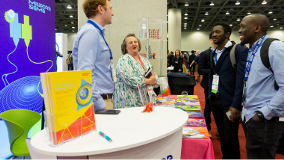Theoretical framework predicts real-world industrial catalytic conditions
Feb 27, 2024|Season 6, Episode 5
In this podcast episode, MRS Bulletin’s Elizabeth Wilson interviews Manos Mavrikakis from the University of Wisconsin–Madison about his group’s theoretical work on real-world industrial catalytic conditions. It is often assumed that most catalyst surface atoms stay in place during a reaction, firmly bonded to their metal neighbors. However, Mavrikakis’s theoretical framework shows that under industrial reaction conditions, a surprising amount of metal–metal bond breaking is likely happening during catalytic reactions. This framework predicts that under reaction conditions, some adsorbed molecules have the strength to scavenge metal atoms from the catalyst particle, causing metal atoms to be ejected to a different spot on the metal surface. Bonds between metal atoms in certain geometries such as kinks can also break, even without adsorbed species, due to heat. However, the presence of reaction molecules may greatly increase the frequency of these events. The ejected metal atoms can then move around on the surface, collect together into groups such as trimers, tetramers, hexamers, or larger ensembles, forming entirely new types of active sites. This work was published in Science.
ELIZABETH WILSON: Welcome to MRS Bulletin’s Materials News Podcast, providing breakthrough news & interviews with researchers on the hot topics in materials research. My name is Elizabeth Wilson. The transition metal surfaces used in heterogeneous catalysis are littered with defects. The different geometries of terraces, edges, kinks, and stray atoms are believed to be the active sites – nanoscale ensembles that actually perform the catalysis. It’s often assumed that most catalyst surface atoms stay in place during a reaction, firmly bonded to their metal neighbors.
But it's impossible to examine what's going on at the surface at an atomic scale, because it's impossible to perform experiments using scanning tunneling microscopy or other spectroscopies under the extreme temperatures and pressures of real-world industrial catalytic conditions.
Now, a team led by Manos Mavrikakis, chemical engineering professor at the University of Wisconsin–Madison, has developed a theoretical framework, which shows that under industrial reaction conditions, a surprising amount of metal–metal bond breaking is likely happening during catalytic reactions.
MANOS MAVRIKAKIS: We remove a major assumption that all along the catalyst community has been making, that bonds between atoms on the catalytic particle can't be broken when the reaction is taking place.
ELIZABETH WILSON: Their framework predicts that under reaction conditions, some adsorbed molecules have the strength to scavenge metal atoms from the catalyst particle, causing metal atoms to be ejected to a different spot on the metal surface. Bonds between metal atoms in certain geometries such as kinks can also break every now and then, even without adsorbed species thanks to heat. However, the presence of reaction molecules may greatly increase the frequency of these events. The ejected metal atoms can then move around on the surface, collect together into groups such as trimers, tetramers, hexamers, or larger ensembles, forming entirely new types of active sites.
MANOS MAVRIKAKIS: So we argue that these clusters of metal atoms generated from the original pristine nanoparticle are actually the active sites.
ELIZABETH WILSON: The formation of new active sites can change the overall dynamics of the catalytic reaction. This new revelation promises to upend how catalytic reactions are studied, both with modeling and experiments. Eventually, it could lead to the development of improved catalysts that are more efficient or operate at lower temperatures and are thus more environmentally friendly.
Their work was motivated by previous experiments from the lab of University of California, Berkeley, chemistry professor Gabor Somorjai and materials science professor Miquel Salmeron. The Berkeley groups studied copper surfaces exposed to carbon monoxide at room temperatures and modest carbon monoxide pressures. Using scanning tunneling microscopy, they showed that metal atoms moved across the surface and clusters formed quickly. Mavrikakis's group turned to theory to explain the underpinnings of this type of behavior as a function of reaction conditions, and for a large number of combinations of metals and reactive species.
MANOS MAVRIKAKIS: Can we use a reliable theoretical framework on the basis of electronic structure calculations, kinetic Monte Carlo calculations, to try to extrapolate now at realistic conditions, and see first if features like this will exist under these conditions, and second, if they exist, what would be their effect on catalytic reaction rates?
ELIZABETH WILSON: They developed models using density functional theory and kinetic Monte Carlo simulations, which allow them to extrapolate these behaviors at hundreds of Kelvin and pressures of several atmospheres. They also included an experimental study of carbon monoxide on a nickel surface. Using scanning tunneling microscopy, they observed behavior at surface dislocations that showed that with increasing pressure, the density of formed clusters increases. The placement of an atom relative to its neighbors, such as its angle or its position on a step edge, or strain in its immediate neighborhood, affects its bond strength, and so affects the ease with which it can detach from its initial position. For example, the framework predicts that under some conditions, the temperature of a catalytic reaction could be reduced by 400 Kelvin if the atoms in a surface defect have a specific geometry and field strain around them. Mavrikakis says he hopes their work will help bridge the gap that exists between fundamental surface science in the lab, and real-world industrial catalytic processes.
MANOS MAVRIKAKIS: Anything we can do to find better catalysts to accelerate chemical reactions with lower thermal energy would help with climate change, would help with anything that has to do with the human race overloading the planet with activity.
ELIZABETH WILSON: This work was published in a recent issue of Science. My name is Elizabeth Wilson from the Materials Research Society. For more news, log onto the MRS Bulletin website at mrsbulletin.org and follow us on X, @MRSBulletin. Don’t miss the next episode of MRS Bulletin Materials News – subscribe now. Thank you. for listening.

